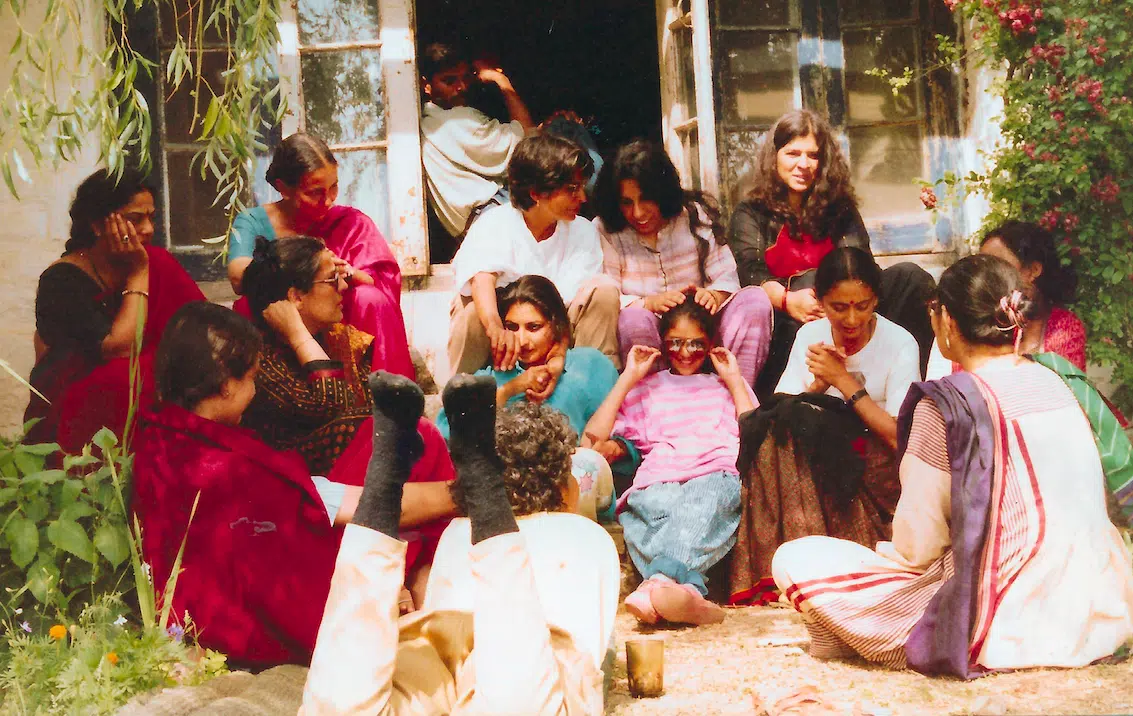This photograph from 1989 captures the gathering of an incredible group of Indian women artists, critics, playwrights, filmmakers, and performers. It was taken from the time they assembled for a seminar on feminism and theatre at the Kasauli Art Centre, which was founded by artist Vivan Sundaram in 1976.
In the back row, from left to right, we see theatre-director and activist Usha Ganguly, artist Nilima Sheikh, theatre-director and educator Anuradha Kapur, feminist scholar and publisher Urvashi Butalia, and theatre-director and filmmaker Anamika Haksar. In the middle row, from left to right, is art critic and curator Geeta Kapur, writer Geetanjali Shree, actress and singer Aditi Rao, and singer and writer Vidya Rao. In the front row, with their backs facing the camera, are historian Samira Sheikh, feminist scholar Nivedita Menon and theatre artist Amba Sanyal. If you look more closely, you will see actor Jitendra Shastri in the background — the sole man in the photograph — looking on attentively.
“The Kasauli Art Centre was a creative and intellectual hub that organized artists’ camps, international residency programs, workshops, and seminars”
I stumbled upon this image while visiting artist Nilima Sheikh’s studio in Baroda last year. It was in an envelope, on which Vivan Sundaram had scribbled a brief note to Sheikh. Sundaram mentioned that he was sending her a selection of photos from their time in Kasauli. This turn of events led to the image being in Sheikh’s possession — not, as one might expect, in Sundaram’s personal collection, where Asia Art Archive had previously found other photographs from the Kasauli Art Centre. This in itself makes for an interesting reflection on how documents circulate and disperse, notions of provenance, and where the locus of the archive is.
The Kasauli Art Centre was a creative and intellectual hub that organized artists’ camps, international residency programs, workshops, and seminars. One of its most enduring contributions was its nurturing of cross-pollination between the arts, where people working in visual art, cinema, music, literature, theatre, architecture, cultural studies, social sciences, and so on, could pursue an interdisciplinary approach. This ferment laid the groundwork for the major publication Journal of Arts and Ideas.
“This photo records a moment in the history of the women’s movement in India when it was deeply concerned with bringing people from diverse fields together in order to raise awareness, push boundaries, and reimagine the public sphere as a more equitable one”
In the year that the photograph was taken, the Kasauli Art Centre hosted two theatre productions — Ghar aur Bahar, based on Rabindranath Tagore’s novel Ghare Baire, and Nayika Bhed. Both plays were directed by Anuradha Kapur and scripted by Geetanjali Shree, with the help of artists like Nilima Sheikh, who designed the set and props. The seminar, which took place in the same week as this image was taken, was titled Representing Women: Fiction and Prescription. Organized by feminist scholar Kumkum Sangari, it took place over three days in the summer of 1989.
This photo records a moment in the history of the women’s movement in India when it was deeply concerned with bringing people from diverse fields together, in order to raise awareness, push boundaries, and reimagine the public sphere as a more equitable one. What struck me most was the casual way the women are huddled outdoors in conversation as a group of peers. It makes for an enchanting scene, and pushes us to wonder, who would be the new subjects of this photograph for the present moment? More significantly, it asks us to think about what new debates, forms of solidarity, and discursive spaces would allow us to tackle the questions and urgencies of the contemporary world.
Asia Art Archive in India will make an extensive collection of documents from Nilima Sheikh’s personal archive freely accessible online in 2019.


